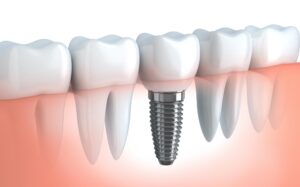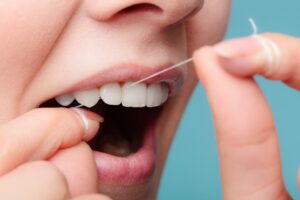Header logo
header top contact widget
Sore or swollen gums
Smokers CAN Lower Oral Health Risks With Proper Measures
Posted on Feb 04, 2021 by William J. Claiborne, DDS MS
If you smoke, you may be tempted to quit as one of your New Year’s resolutions. By now, you may be “over the hump” and feel success in this challenge (and breathing much easier!). Good for you!
However, if you’ve stumbled and faltered (and perhaps even thrown up your hands in defeat), you are not alone. According to the Centers for Disease Control & Prevention (CDC), over 55 percent of smokers in the U.S. had made a quit attempt in 2018, with only 7.5 percent succeeding. (https://www.cdc.gov/tobacco/data_statistics/fact_sheets/cessation/smoking-cessation-fast-facts/index.html)
Yet, less than 7 percent of adult smokers reported (in 2015) that they had sought counseling or medications in their attempts to quit. Yet, the need for support is clear. For most people who are trying to quit, it is a long, tough journey. The CDC also reports that:
“more people in the United States are addicted to nicotine than to any other drug. Research suggests that nicotine may be as addictive as heroin, cocaine, or alcohol.”
As the need to maintain healthy immune systems has never been more urgent, smokers will hopefully reach out to every source in order to kick the habit, for good. Data assembled by a team at the University of California (San Francisco) found that smoking nearly doubles the rate of COVID progression.
The analysis took into account over 11,500 COVID patients. The findings showed by current and former smokers were twice as likely to have conditions that require hospitalization and higher death rates. (https://www.ucsf.edu/news/2020/05/417411/smoking-nearly-doubles-rate-covid-19-progression)
The authors of the study warned that both cigarettes and e-cigs were involved in this higher risk rate.
Smoking increases mucus production and inflammation, which injures the lungs’ defense system. This is why people who smoke are more likely to have serious respiratory infections and illnesses.
However, my role as an Asheville periodontist is not to lecture our patients. We believe our patients deserve to be informed about the risks to their oral health, in particular, and provide encouragement. Too, we want patients to understand the best ways to avoid developing periodontal (gum) disease and the subsequent repercussions (such as tooth loss) as a result.
So, let’s focus on your periodontal health if you smoke (including cigarette smoking or vaping).
Smokers are often unaware of what occurs in the mouth from smoking. To begin, smokers have a greater risk of periodontal (gum) disease due to its drying effect on the soft tissues in the mouth. When saliva flow is depleted, its ability to rinse away oral bacteria enables the mouth to a bacterial breeding ground.
As oral bacteria reproduce and accumulate in the mouth, gum tissues become inflamed. In the early stages of gum disease, symptoms may include frequent bad breath, tender and swollen gums, and gums that bleed easily when brushing teeth.
As gum disease progresses, the gums change in color from a healthy pink hue to red. The gums loosen their grip around the base of teeth and seem more spongy. Breath odor is consistently bad. Pus pockets may form at the base of some teeth.
Eventually, the bone and the tissue structures that support natural teeth are under attack. The infectious bacteria ramp up their onslaught of attack, tooth roots no longer have the firm support they need. Some teeth begin to loosen and may require removal.
Advanced periodontal disease, known as periodontitis, is a health risk that goes far beyond the mouth. For years, research has shown an intricate connection between the “good” bacteria in the mouth, especially beneficial in gut health. It has also been known that the “bad” and infectious bacteria of advanced gum disease can alter the roles of certain factors in the body that help to prevent the formation of disease.
For example, certain cancers can be activated or progressed through the inflammatory bacteria of gum disease. These bacteria are able to become blood borne and activate “pathogens” that create a domino effect of disease development.
When you factor in the vulnerability to the lungs from inhaling the toxic smoke of cigarettes, you have a perfect storm. Consider that the gum tissues are the first contact with these inhaled chemicals. Because oral tissues are absorbent in nature, they are at the front line of smoking’s effect.
If you do smoke, we want to help you minimize the risks it poses to your oral health. In addition to maintaining regular dental check-ups and cleanings (at least every 6 months), below are some tips for your at-home oral hygiene regimen.

• Brush twice a day (at least) for two minutes each time. Use a fluoridated toothpaste and a soft to medium bristle toothbrush.
• Floss your teeth every day and floss before your brush. You would be surprised at how many particles can be lodged between teeth that brushing won’t rid. If flossing is an awkward maneuver, try one of the water flossers, which are affordable and as effective as manual flossing.
• Brush your tongue after your teeth to unroot embedded bacteria, especially reaching the back area of the tongue (where most bacteria are embedded). This also helps to give you fresh breath.
• Use an oral rinse that replenishes moisture (and is alcohol-free) twice a day (or as directed). These are available OTC at most drug stores.
• Chew sugarless gum, preferably a brand that contains Xylitol. Xylitol looks and tastes like sugar, yet has 40 percent fewer calories.
• Drink plenty of water throughout the day. Be aware that beverages such as most coffee, tea and colas contain caffeine are drying to the mouth. Many medications also have the side effect of oral dryness – another good reason to stay hydrated.
• Limit your intake of sugar and carbohydrates. These are oral bacteria super boosters.
In our Asheville periodontal dental office, please know that we are here for you regardless of your needs or goals. Although we prefer you give up smoking, we want to give you the very best care possible so you can enjoy a healthy mouth and confident smile.
If you haven’t had regular dental exams or have any of the symptoms associated with gum disease (mentioned above), call our dental office to schedule a thorough periodontal exam at 828-274-9440.
Missing Teeth? Know The Ends-&-Outs of Dental Implants
Posted on Jan 29, 2021 by William J. Claiborne, DDS MS
 If you are one of the millions of adults who are missing one or more natural teeth, you are actually in the majority if you are over the age of 50.
If you are one of the millions of adults who are missing one or more natural teeth, you are actually in the majority if you are over the age of 50.
According to the Centers of Disease Control & Prevention (CDC), by the age of 50, Americans have lost an average of 12 teeth. For those between the ages of 50 to 64, over 10 percent have no remaining natural teeth. Twenty-six percent – more than one-fourth – of adults between 65 – 74, have lost ALL of their natural teeth.
Replacing natural teeth may seem simple. Often, people assume that a partial or bridge will solve the problem. Yet, these dental appliances merely worsen an already precarious situation. While these dental prosthetics “mimic” the appearance of teeth, what’s occurring beneath the gum line has a significant impact on what’s to come.
To understand the rocky road in the future, consider the foundation of natural teeth – the jaw bone.
The reason biting and chewing occurs dependably and with stability with natural teeth is because they are secured by the jaw bone. When natural teeth are removed, their roots are no longer present in the jaw bone. The presence of these roots actually provides stimulation to the jaw bone, which helps to preserve the bone’s mass. Without this stimulation, the bone resorbs, a process of which bone mass “melts away”.
Resorption is to blame for dentures or partials that start to move or slip over time, even though the fit was snug when first made. Because resorption reduces bone height, the ridge the denture was contoured to fit begins to flatten. A shrinking ridge leaves the denture with an insufficient base.
The pace of bone loss speeds up a little more each year. The pressure of a denture on the ridge accelerates the rate. For people who sleep in their dentures or partials, the continual pressure ramps up the pace further.
As the ridge flattens, denture adhesives or pastes become of little help while trying to eat. This leads many denture wearers to switch to a diet of soft foods that dissolve easily in the mouth. Often, the pleasure of eating is overshadowed by trying to avoid sore spots on tender gum tissues or embarrassing slips.
Declining bone mass also leads to changes in facial appearance, contributing to an appearance that is far older than one’s actual age. As bone mass declines, jowls form as facial muscles detach from a shrinking bone mass. Deep wrinkles form around the mouth and the corners of the mouth turn downward, even in a smile. As bone loss becomes severe, the chin points and the nose moves closer to the chin, creating a ‘granny look.’
As an Asheville periodontist, my dental specialty includes the diagnosis and placement of dental implants. Dental implants are the closest thing to natural teeth, for many reasons.
Dental implants restore the ability to bite and chew comfortably and without the fear of embarrassment or uncomfortable rubbing. Because implants are placed in the jaw bone, they have the same dependable foundation as that of natural teeth.
Among the many benefits of dental implants, they also provide stimulation to the jaw bone. This helps to halt the process of bone loss. For those who have already lost a great deal of bone loss, bone rebuilding procedures can be performed to restore a healthy, more youthful face shape.
An added advantage of implants is they do not rely on the crowning of otherwise healthy, neighboring teeth for the mere purpose of supporting a bridge. While a traditional crown-&-bridge combination relies on crowned teeth for support, an implant uses the sturdy foundation of your jaw bone.
There are over 40 different types of dental implant systems, each designed to accommodate specific needs and goals. For example, some implants are designed for placement in minimal bone mass. Others can be strategically placed to support a bridge of two or more teeth or support a full arch.
When choosing Dental Implants to replace teeth, you are making a lifelong investment. Since implants are designed to last a lifetime, they provide a ‘one & done’ choice for dependable tooth replacement. There are not many things these days that give you so much value!
If you struggle with dental fear or anxiety, rest assured that patient comfort – at every appointment – is of the highest priority. Our office is structured to attend to the specific needs of each patient, gently and respectfully. Patients begin with a consultation in a comfortable, private setting rather than seated in a treatment chair.
For patients who desire a “sleep” state, we offer oral sedation as well as I.V. sedation (twilight sleep). Oral sedation is a pill that helps patients relax. It also has an amnesiac effect, leaving most with little or no memory of treatment afterward.
I.V. sedation places the patient in a deeper sedative state (twilight sleep), also erasing memory of the procedure. It is administered by a doctor of anesthesiology for optimal comfort and safety.
With both, patients are closely monitored with advanced safety equipment throughout treatment. Patients also find our entire staff to be a unified team, each bringing a sincere level of compassion and commitment to excellent care.
Rather than bypass the very best option for replacing lost teeth, consider a consultation to discuss the benefits, anticipated costs, and treatment process. Call 828-274-9440 for an appointment in our Asheville periodontal dental office.
Erectile Dysfunction (ED) Risks Increase With Presence of Gum Disease
Posted on Jan 07, 2021 by William J. Claiborne, DDS MS
Men have a long way to go when it comes to taking good care of their teeth and gums, according to several surveys.
One from the Academy of General Dentistry stated that men in the U.S. are less likely to have regular dental check-ups and cleanings than women. Another survey shared by the Journal of Periodontology said men are less likely to brush regularly, and more likely to lose teeth as they age as well as develop oral cancer and gum disease.
According to the Centers for Disease Control & Prevention, over 56 percent of men have gum disease, compared to just over 38 percent of women. Men, in particular, should be aware of the increased health risks associated with periodontal (gum) disease.
Researchers have given closer assessment to recent studies and found that erectile dysfunction (ED) is more common in men with gum disease.
In addition to higher ED risks, research has found that men with a history of gum disease are 14 percent more likely to develop cancer than men with healthy gums – 49 percent more likely to develop kidney cancer, 59 percent more likely to develop pancreatic cancer and 30 percent more likely to develop a blood cancer.
If concerns about heart disease and cancers aren’t enough to get men thinking more seriously about their oral health, ED may be a condition that does.
Gum disease has emerged as an independent risk factor for cardiovascular disease, and cardiovascular disease raises the risk for ED. For men, there are a number of factors that contribute to an increased risk of cardiovascular disease. These include smoking, obesity, chronic stress, high cholesterol, high blood pressure, and chronic sleep apnea.
One study published in the Journal of Sexual Medicine revealed that men in their thirties with severe gum disease are 3 times more likely to have erection problems. As cardiovascular health issues develop, erection ability suffers, and as health problems increase in number and severity, so does the severity of ED.
The association between periodontal disease, heart disease, and erectile dysfunction relates to inflammation brought on by gum disease bacteria. This process actually comes down to a biochemical reaction. During sexual arousal, the body releases nitric oxide, which plays a key role in enabling erection. Chronic inflammations, including periodontal disease, impairs release of nitric oxide and contributes to ED.
In the U.S., an estimated 18 percent of males have erectile dysfunction. Although men who are over age 70 are more likely to have ED, males most affected by ED are getting younger. One outpatient clinic showed that 1 in 4 men who sought help for erectile dysfunction were under the age of 40.
Could maintaining a healthy mouth lower the risk of ED? In a 2013 study, it was found that treating periodontal disease improves ED symptoms. Thus, a growing number of physicians are advising male patients who have both ED and periodontitis to seek periodontal treatment as a way to reduce its risk.
In data analyzed from five studies published between 2009 – 2014 (which included 213,000 male participants between ages 20 – 80), men who had chronic periodontitis (advanced gum disease) were more likely to have erectile dysfunction.
In another study, nearly half of the men with ED also had diabetes, another chronic inflammatory disease with links to periodontal disease. Chronic inflammation in the body can be lowered when gum health is kept in good condition.
Men can help to protect their overall health by keeping their oral health at an excellent level. It is especially important to watch for signs of gum disease. Symptoms include: puffy, red gums; inflamed, swollen, or bleeding gums; gums that recede from the base of teeth; and persistent bad breath.
If you are experiencing any of these symptoms, call our Asheville periodontal dental office for an examination as soon as possible. Gum disease does not improve without treatment.
Although many serious health problems are linked to the potent bacteria of gum disease, it is one of the most preventable of all diseases. Twice daily brushing, daily flossing, a diet limited in sugar and carbohydrates and drinking plenty of water are simple guidelines to follow.
Even with these easy steps that take mere minutes per day, it is estimated that over 47 percent of American adults have some level of gum disease.
For the good of your overall health and well-being, renew your commitment to a healthy smile for the new year. Begin with a thorough examination. (A referral is not required.) We’ll discuss how to get your oral health in good shape and ways to maintain it between dental check-ups.
Call 828-274-9440 to schedule or ask to begin with a consultation. If dental anxiety or fear has kept you from regular dental care, mention this during your appointment. This is a common problem for both men and women. If desired, we offer a number of comfort options, including Oral Sedation or I.V. Sedation (twilight sleep).
Ask Santa To Make The Toothbrush Under The Tree Electric!
Posted on Dec 16, 2020 by William J. Claiborne, DDS MS
Although your Christmas wish list probably doesn’t include an electric toothbrush, it should. Studies have shown that brushing teeth with an electric version promotes better gum health and slower progression of periodontal (gum) disease. Electric tooth brushing is also helpful in reducing tooth loss, by 20 percent (compared to those who brush with manual toothbrushes).
If you use an electric toothbrush, most people think of its benefits in giving fresh breath and a bright smile. As an Asheville periodontist for over three decades, I have a firsthand view of how a thorough at-home oral hygiene regimen can help significantly in preventing gum disease and tooth loss.
An electric toothbrush can be an important tool in daily oral hygiene. Findings of an 11 year study published in the Journal of Clinical Periodontology tracked the oral health of over 2800 adults. The use of electric toothbrushes was monitored to watch for periodontal disease, cavities, and the number of natural teeth.
From 2002 – 2006, participants were examined with follow ups conducted after 6 and 11 years. Eighteen percent of the participants were electric tooth brush users. At the time of their 11 year follow up, 37 percent had switched to using electric toothbrushes.
Although more adults are using them, the long-term effectiveness of electric tooth brushes has not been proven to be significant. It is suspected that this is due to the technique used rather than due to the brushing tool itself. For manual users, a significant challenge with brushing this way is in the choice of bristles. Stiff, hard bristles can be very damaging.
A hard bristled tooth brush can actually damage tooth enamel and gum tissues. To the detriment of teeth, people tend to press down too firmly as they brush, scrubbing with a ‘back & forth’ motion. They may feel this is the way to do a good job brushing. However, this action can wear down the protective coating of tooth enamel, leaving teeth more vulnerable to decay.
Another problem with a hard bristle tooth brush is its ability to damage tender gum tissues. These can thin out the protective seal that gums have around the base of each tooth. This increases the potential for bacterial entry of the sensitive tooth root area of teeth.
Hint: If the bristles on your toothbrush are fanned out after a couple of months, you are applying too much pressure when brushing.
The ideal technique for brushing teeth is to use gentle pressure with a swirling motion. By using a circular pattern over both sides of each tooth and along the tops, teeth are cleansed without wearing away gum tissues or wearing down precious tooth enamel.
This is where electric toothbrushes can help greatly. Many of the newer models include a beep when too much pressure is being applied. Most also have timers to indicate the time needed for each quadrant, which is your teeth divided into 4 sections. The timers are good aids in helping you to brush at least two minutes.
As devastating as tooth loss can be to one’s overall health, we now know that the bacteria of gum disease can enter the bloodstream. Research has shown this infectious bacteria can trigger inflammatory reactions elsewhere in the body. It has been linked to heart disease, stroke, high blood pressure, some cancers, diabetes, arthritis, impotency, preterm babies and more.
Whether using a manual or electric tooth brush, it is necessary to brush twice a day to effectively remove plaque. Plaque is the sticky film you feel on teeth when you wake up or at the end of the day.
Plaque is a buildup of oral bacteria that coats teeth and gums. If not removed daily, it forms a hardened mass of calculus (or tartar) that attaches to teeth. This is what you may feel your hygienist scraping off teeth during cleanings since it cannot be brushed or flossed away.
Another place that oral bacteria can thrive are in the grooves in the tongue. These offer a dark, warm and moist environment for bacterial reproduction. To uproot these icky organisms, use your toothbrush to brush your tongue after brushing teeth. Be sure to reach the back of the tongue where the majority of oral bacteria are embedded. Swish with water several times after.
Flossing is another way to improve gum health, lower cavity risk and prevent tooth loss. It is estimated that only 31 percent of American adults floss on a daily basis. Flossing removes trapped bits of food remain in the mouth, which feeds oral bacteria and allows them to quickly multiply. Because brushing cannot dislodge all food particles caught between tee th, daily flossing should be a part of oral hygiene routines.
th, daily flossing should be a part of oral hygiene routines.
Proper flossing is easy for those who are in the habit and takes only a minute each day. For those who have difficulty with manual dexterity or find the maneuver awkward, water flossers are effective alternatives and easy to use. (This is another good item to add to your wish list!)
Practice these recommended techniques and you’ll not only do a better job at having a clean mouth, you’ll find your time at the sink requires less effort. If you feel you may be experiencing symptoms of periodontal disease, act promptly. You should be seen at your earliest convenience for treatment since this disease will only worsen over time.
Signs of gum disease include tender gums that bleed easily when brushing, gums that darken in color to red (versus a healthy pink), frequent bad breath, and gums that pull away from teeth (receded gums) and expose darker root areas of the tooth.
As a periodontal specialist, I have advanced skills in the treatment of all stages of gum disease (as well as in the placement of dental implants). Our office features some of the most advanced technology available in dentistry to optimize patient outcomes and comfort.
Here, we will help you achieve the healthy smile you want and prevent tooth loss to the greatest extent possible. If you’ve already lost teeth, we’ll discuss their replacement through dental implants. Dental implants are the closest thing to natural teeth, restoring biting and chewing strength and stability.
Call 828-274-9440 to learn more or to schedule a consultation to discuss how you can achieve excellent oral health.
Recent Posts
Categories
Archives
- September 2024
- August 2024
- July 2024
- June 2024
- May 2024
- April 2024
- March 2024
- February 2024
- January 2024
- December 2023
- November 2023
- October 2023
- September 2023
- August 2023
- July 2023
- June 2023
- May 2023
- April 2023
- March 2023
- February 2023
- January 2023
- December 2022
- November 2022
- October 2022
- September 2022
- August 2022
- July 2022
- June 2022
- May 2022
- April 2022
- March 2022
- February 2022
- January 2022
- December 2021
- November 2021
- October 2021
- September 2021
- August 2021
- July 2021
- June 2021
- May 2021
- April 2021
- March 2021
- February 2021
- January 2021
- December 2020
- November 2020
- October 2020
- September 2020
- August 2020
- July 2020
- June 2020
- May 2020
- April 2020
- March 2020
- February 2020
- January 2020
- December 2019
- November 2019
- October 2019
- September 2019
- August 2019
- July 2019
- June 2019
- May 2019
- April 2019
- March 2019
- February 2019
- January 2019
- December 2018
- November 2018
- October 2018
- September 2018
- August 2018
- July 2018
- June 2018
- May 2018
- April 2018
- March 2018
- February 2018
- January 2018
- December 2017
- November 2017
- October 2017
- September 2017
- August 2017
- July 2017
- June 2017
- May 2017
- April 2017
- March 2017
- February 2017
- January 2017
- December 2016
- November 2016
- October 2016
- September 2016
- August 2016
- July 2016
- June 2016
- May 2016
- April 2016
- March 2016
- February 2016
- January 2016
- December 2015
- November 2015
- October 2015
- September 2015
- August 2015
- July 2015
- June 2015
- May 2015
- April 2015
- March 2015
- February 2015
- January 2015
- December 2014
- November 2014
- October 2014
- September 2014
- August 2014
- July 2014
- June 2014
- May 2014
- April 2014
- March 2014
- February 2014
- January 2014
- December 2013
- November 2013
- October 2013
- September 2013
- August 2013
- July 2013
- June 2013
- May 2013
- April 2013
- March 2013
- February 2013
- January 2013
- December 2012
- November 2012
- October 2012
- September 2012
- August 2012
- July 2012
- June 2012


